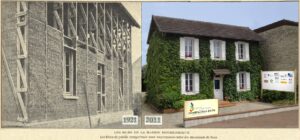I have been looking for a way to talk about the end of the house.
A house should allow for alterations and refurbishment – using materials that can be sawn, drilled into and bolted onto. Like the Walter Segal houses, where the modular wooden structure and moveable partitions make it relatively easy to change internal layouts or add another room. Or Sarah Wigglesworth’s project to refurbish her home and office at Stock Orchard Street, which has made the pioneering strawbale house more energy efficient and more suitable for aging inhabitants.
But even with alterations over a long lifetime, at some point a house might need to be demolished. Say flood patterns have changed – a nearby river regularly bursts its banks and the house is flooded for weeks at a time, every year. It becomes uninhabitable. Can we build in such a way that we can dismantle it efficiently? Compost some materials and reuse others?
If I say that a house is built of natural materials that can rot, biodegrade, return to the soil… The word ‘rot’ does not belong in advertising copy. Houses should last. Houses should be safe as houses. Invest in bricks and mortar. Don’t mention the three little pigs! Introducing the word ‘rot’ is like a making a hole in the plaster. It lets in the very idea of decay.
Organic materials can be very long-lasting when well maintained. Hundred-year-old straw bale houses are still being used, including mansions and a church in Nebraska and Alabama and the Maison Feuillette in France, home of the French Straw Bale Association.* I recently visited Whitehall Historic House in Cheam where the spaces between 500-year-old wooden studs in the walls are filled with ‘rye dough’, a mixture of clay and straw. Left on the ground in the open air, a handful of straw would rot away to nothing in a year or two. In exposed sections of the wall at Whitehall, bits of straw that are hundreds of years old can be seen in the mixture – it’s hard and dry to the touch, though it absorbs and releases moisture from the air.
Bricks, steel and concrete also have to be carefully produced, with attention to the component materials and the potential interactions between elements of the finished building. Thousands of new homes in Donegal and Mayo in Ireland are now crumbling because they were built of concrete bricks that contained too much mica. Mica reduces the strength of the concrete, results in a poorer bond with cement and absorbs water, making the bricks vulnerable to cracking in freezing weather.
How to talk about these miraculous materials that are sturdy and resilient as long as they’re needed but capable of breaking down entirely, through the action of microbes? I came across an article by Catherine Slessor about a house made entirely of cork:
‘When its time does come the house can be dismantled with minimal environmental impact. As a bio-renewable resource, the cork blocks can either be recycled or broken down and returned to the earth. The aim is to leave no trace.’
My mind skates over the words minimal environmental impact. How minimal is minimal? How is ‘the environment’ defined here – local, global, living, human? The ‘environment’ has been invoked in so many misleading and empty ways, printed on the sides of plastic water bottles and in strategy documents.
But I like this phrase: When its time does come…Houses have a lifespan, like living beings.
I try adapting the words for the description of the strawbale house I want to build: ‘When its time does come, the straw can be returned to the earth. The aim is to leave no trace.’

* A Complete Guide to Straw Bale Building, Rikki Nitzkin and Maren Termens (2020, Permanent Publications), pp. 11- 16.